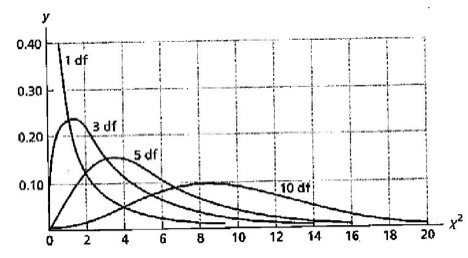Chi square analysis description/sample writing
Chi square analysis, a nonparametric statistical procedure used to examine differences in noncontiguous, discrete data, was conducted to determine if there was a significant difference in factors that influenced nurses’ choice to be immunized against influenza. A null hypothesis, assumed that there would be no difference in distribution across demographic groups.
The chi square distribution is depicted in Figure 1. The Chi Square statistic compares the tallies or counts of categorical responses between two or more independent groups. Comparisons occur between the observed frequencies and the theoretical or mathematically modeled expected frequencies (see Figure 2). This is referred to as the goodness-of-fit.
Figure 1. Chi square distribution for 1, 3, 5, and 10 degrees of freedom from: Hinkle, Wiersma, & Jurs, 2003
where k is the number of categories, groupings or possible outcomes
Figure 2. Mathematical calculation of chi square
To determine which factors were the major contributors to the significance of the chi square value, standard residuals (R) were calculated (see Figure 3). When the absolute value of the R is greater than 2, it is reasonable to conclude that factor to be major contributor to the chi square value and thus, the factor that is significantly different.
Figure 3. Mathematical calculation of the standard residual
contributed by Frank LaBanca, EdD


